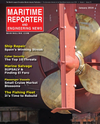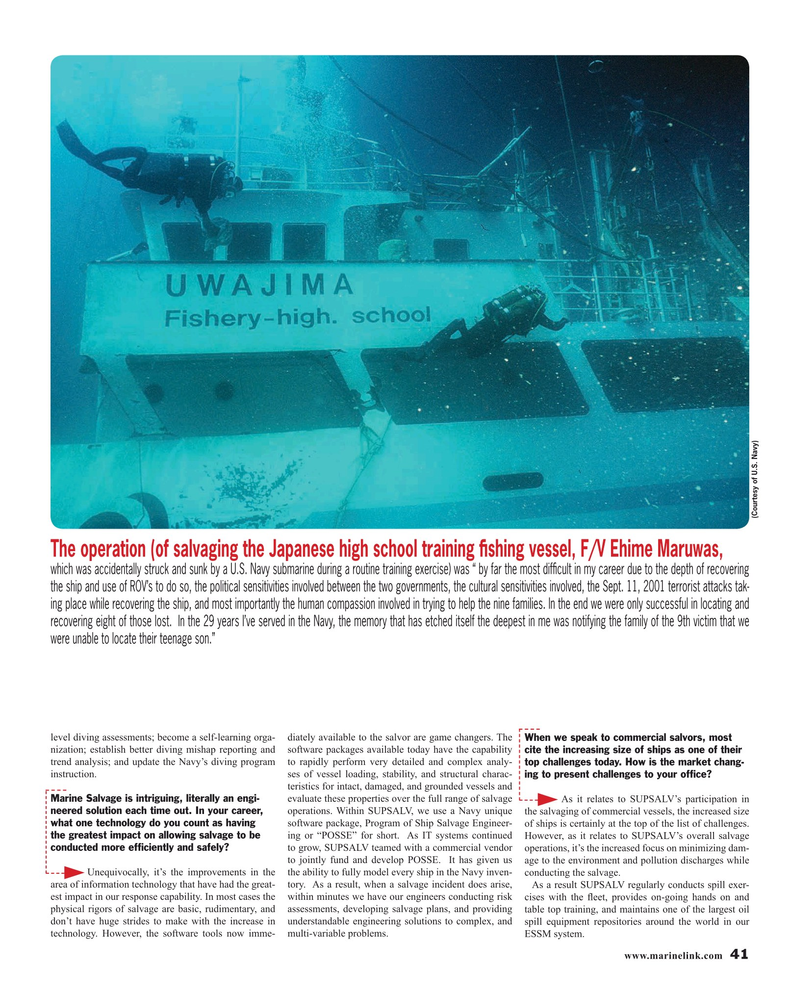
Page 41: of Maritime Reporter Magazine (January 2016)
Ship Repair & Conversion Edition
Read this page in Pdf, Flash or Html5 edition of January 2016 Maritime Reporter Magazine
(Courtesy of U.S. Navy)
The operation (of salvaging the Japanese high school training ? shing vessel, F/V Ehime Maruwas, which was accidentally struck and sunk by a U.S. Navy submarine during a routine training exercise) was “ by far the most dif? cult in my career due to the depth of recovering the ship and use of ROV’s to do so, the political sensitivities involved between the two governments, the cultural sensitivities involved, the Sept. 11, 2001 terrorist attacks tak- ing place while recovering the ship, and most importantly the human compassion involved in trying to help the nine families. In the end we were only successful in locating and recovering eight of those lost. In the 29 years I’ve served in the Navy, the memory that has etched itself the deepest in me was notifying the family of the 9th victim that we were unable to locate their teenage son.” level diving assessments; become a self-learning orga- diately available to the salvor are game changers. The
When we speak to commercial salvors, most nization; establish better diving mishap reporting and software packages available today have the capability cite the increasing size of ships as one of their trend analysis; and update the Navy’s diving program to rapidly perform very detailed and complex analy- top challenges today. How is the market chang- instruction. ses of vessel loading, stability, and structural charac- ing to present challenges to your of? ce?
teristics for intact, damaged, and grounded vessels and
Marine Salvage is intriguing, literally an engi- evaluate these properties over the full range of salvage As it relates to SUPSALV’s participation in neered solution each time out. In your career, operations. Within SUPSALV, we use a Navy unique the salvaging of commercial vessels, the increased size what one technology do you count as having software package, Program of Ship Salvage Engineer- of ships is certainly at the top of the list of challenges. the greatest impact on allowing salvage to be ing or “POSSE” for short. As IT systems continued However, as it relates to SUPSALV’s overall salvage conducted more ef? ciently and safely?
to grow, SUPSALV teamed with a commercial vendor operations, it’s the increased focus on minimizing dam- to jointly fund and develop POSSE. It has given us age to the environment and pollution discharges while Unequivocally, it’s the improvements in the the ability to fully model every ship in the Navy inven- conducting the salvage. area of information technology that have had the great- tory. As a result, when a salvage incident does arise, As a result SUPSALV regularly conducts spill exer- est impact in our response capability. In most cases the within minutes we have our engineers conducting risk cises with the ? eet, provides on-going hands on and physical rigors of salvage are basic, rudimentary, and assessments, developing salvage plans, and providing table top training, and maintains one of the largest oil don’t have huge strides to make with the increase in understandable engineering solutions to complex, and spill equipment repositories around the world in our technology. However, the software tools now imme- multi-variable problems. ESSM system.
www.marinelink.com 41
MR #1 (34-41).indd 41 1/6/2016 11:24:03 AM

 40
40

 42
42
